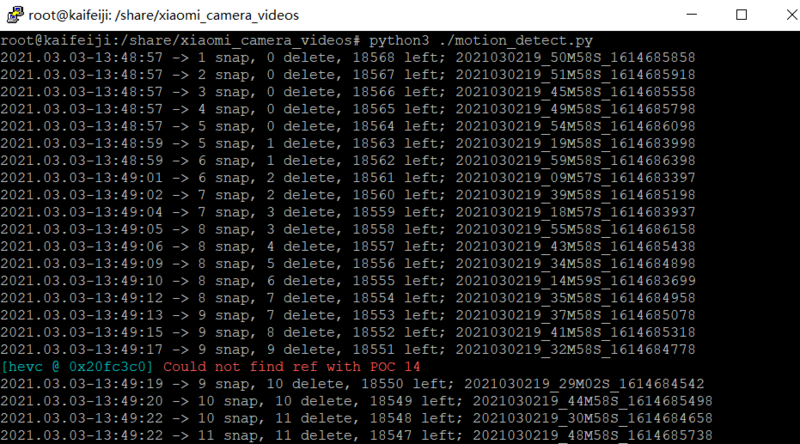1
2
3
4
5
6
7
8
9
10
11
12
13
14
15
16
17
18
19
20
21
22
23
24
25
26
27
28
29
30
31
32
33
34
35
36
37
38
39
40
41
42
43
44
45
46
47
48
49
50
51
52
53
54
55
56
57
58
59
60
61
62
63
64
65
66
67
68
69
70
71
72
73
74
75
76
77
78
79
80
81
82
83
84
85
86
87
88
89
90
91
92
93
94
95
96
97
98
99
100
101
102
103
104
105
106
107
108
109
110
111
112
113
114
115
116
117
|
import os
import datetime
import imutils
import time
import cv2
// 设置视频所在的根目录,Windows示例:C:\\Users\\abc\\desktop
base_path = '/share/xiaomi_camera_videos/788b2a9faf02'
// 获取文件列表函数
def get_filelist(dir):
Filelist = []
for home, dirs, files in os.walk(dir):
for file_name in files:
Filelist.append(os.path.join(home, file_name))
return Filelist
// 检测视频是否有活动画面
def is_video_occupied(video_path):
camera = cv2.VideoCapture(video_path)
total = camera.get(cv2.CAP_PROP_FRAME_COUNT)
fps = camera.get(cv2.CAP_PROP_FPS)
step = (total - 100) / 9
lastFrame = None
occupied = False
for i in range(100, int(total), int(step)):
camera.set(cv2.CAP_PROP_POS_FRAMES, i)
camera.grab()
(grabbed, frame) = camera.read()
if not grabbed:
break
frame = imutils.resize(frame, width=500)
camera_area = frame.shape[0] * frame.shape[1]
gray = cv2.cvtColor(frame, cv2.COLOR_BGR2GRAY)
gray = cv2.GaussianBlur(gray, (21, 21), 0)
if lastFrame is None:
lastFrame = gray
continue
frameDelta = cv2.absdiff(lastFrame, gray)
thresh = cv2.threshold(frameDelta, 25, 255, cv2.THRESH_BINARY)[1]
thresh = cv2.dilate(thresh, None, iterations=2)
(cnts, _) = cv2.findContours(thresh.copy(), cv2.RETR_EXTERNAL,
cv2.CHAIN_APPROX_SIMPLE)
lastFrame = gray
for c in cnts:
ca = cv2.contourArea(c)
if ca < 500 or ca > camera_area/2:
continue
occupied = True
break
else:
continue
break
camera.release()
return occupied,frame
// 获取文件列表
filelist = get_filelist(base_path)
// 创建缩略图文件夹
snap_path = os.path.join(os.path.abspath(os.path.join(base_path,os.path.pardir)),'snapshots')
if not os.path.exists(snap_path):
os.makedirs(snap_path)
delete = 0
snap = 0
left = len(filelist)
// 循环文件列表
for video_path in filelist:
date_name = os.path.basename(os.path.dirname(video_path))
file_name = os.path.splitext(os.path.basename(video_path))[0]
jpg_path = os.path.join(snap_path,date_name+'_'+file_name+'.jpg')
if os.path.exists(jpg_path):
snap = snap + 1
else:
occupied, snapshot = is_video_occupied(video_path)
// 动态视频截图保存
if (occupied):
cv2.imwrite(jpg_path, snapshot)
snap = snap + 1
// 静态视频直接删除
else:
os.remove(video_path)
delete = delete + 1
left = left - 1
// 屏幕显示进度
cur_time = datetime.datetime.now().strftime("%Y.%m.%d-%H:%M:%S")
print(f'{cur_time} -> {snap} snap, {delete} delete, {left} left; {date_name}_{file_name}')
// 删除空文件夹
for root, dirs, files in os.walk(base_path):
if dirs == files:
os.rmdir(root)
|
